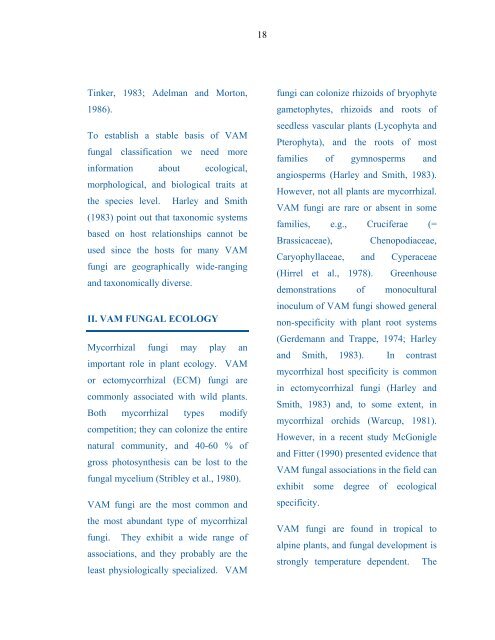18Tinker, 1983; Adelman <strong>and</strong> Morton,1986).To establish a stable basis of VAMfungal classification we need moreinformation about ecological,morphological, <strong>and</strong> biological traits atthe species level. Harley <strong>and</strong> Smith(1983) point out that taxonomic systemsbased on host relationships cannot beused since the hosts for many VAMfungi are geographically wide-ranging<strong>and</strong> taxonomically diverse.II. VAM FUNGAL ECOLOGYMycorrhizal fungi may play animportant role in plant ecology. VAMor ectomycorrhizal (ECM) fungi arecommonly associated with wild plants.Both mycorrhizal types modifycompetition; they can colonize the entirenatural community, <strong>and</strong> 40-60 % ofgross photosynthesis can be lost to thefungal mycelium (Stribley et al., 1980).VAM fungi are the most common <strong>and</strong>the most abundant type of mycorrhizalfungi. They exhibit a wide range ofassociations, <strong>and</strong> they probably are theleast physiologically specialized. VAMfungi can colonize rhizoids of bryophytegametophytes, rhizoids <strong>and</strong> roots ofseedless vascular plants (Lycophyta <strong>and</strong>Pterophyta), <strong>and</strong> the roots of mostfamilies of gymnosperms <strong>and</strong>angiosperms (Harley <strong>and</strong> Smith, 1983).However, not all plants are mycorrhizal.VAM fungi are rare or absent in somefamilies, e.g., Cruciferae (=Brassicaceae), Chenopodiaceae,Caryophyllaceae, <strong>and</strong> Cyperaceae(Hirrel et al., 1978). Greenhousedemonstrations of monoculturalinoculum of VAM fungi showed generalnon-specificity with plant root systems(Gerdemann <strong>and</strong> Trappe, 1974; Harley<strong>and</strong> Smith, 1983). In contrastmycorrhizal host specificity is commonin ectomycorrhizal fungi (Harley <strong>and</strong>Smith, 1983) <strong>and</strong>, to some extent, inmycorrhizal orchids (Warcup, 1981).However, in a recent study McGonigle<strong>and</strong> Fitter (1990) presented evidence thatVAM fungal associations in the field canexhibit some degree of ecologicalspecificity.VAM fungi are found in tropical toalpine plants, <strong>and</strong> fungal development isstrongly temperature dependent. The
19fungi are distributed over a wide rangeof soil habitats, including soil of aridregions of Pakistan (Khan, 1974), semiaridregions in the USA (Reeves et al.,1979), semi-arid regions of Senegal(Diem et al., 1981), semi-arid regions ofAustralia (McGee, 1989), dry sahelregion of Nigeria (Redhead, 1977), tothe wet soils of marshes (Dowding,1959).<strong>Mycorrhizae</strong> are common in s<strong>and</strong> duneplants. Stahl (1900) first reported theoccurrence of mycorrhizal associationswith s<strong>and</strong> dune plant roots. Asai (1934)also reported the occurrence ofmycorrhizal associations in s<strong>and</strong> duneplants. Studies on mycorrhizalassociations in s<strong>and</strong> dune plants inAustralia (Jehne <strong>and</strong> Thompson, 1981),in the USA (Koske <strong>and</strong> Halvorson,1981; Sylvia, 1986), <strong>and</strong> in Europe(Giovannetti <strong>and</strong> Nicolson, 1983; Ernestet al., 1984; Puppi et al., 1986; Read1989) indicated that dominant plants <strong>and</strong>pioneer grasses are normally associatedwith VAM fungi.Much attention has been given to theeffect of VAM fungi on maritime s<strong>and</strong>dune plants. The fungi aid in thesuccessful establishment of plantspecies, in the improved nutrient statusof the dune plants, <strong>and</strong> in s<strong>and</strong> dunestabilization (Nicolson, 1959, 1960;Koske, 1975; Koske et al., 1975; Sutton<strong>and</strong> Sheppard, 1976; Nicolson <strong>and</strong>Johnston, 1979; Koske <strong>and</strong> Halvorson,1981; Jehne <strong>and</strong> Thompson, 1981;Koske <strong>and</strong> Walker, 1984; Koske <strong>and</strong>Polson, 1984; Halvorson <strong>and</strong> Koske,1988).. Earlier work in Scotl<strong>and</strong> showedthat VAM fungi are important to s<strong>and</strong>dune grasses (Nicolson, 1959 <strong>and</strong> 1960).Halvorson <strong>and</strong> Koske (1988) reportedthat VAM fungi, among all othermycorrhizal types, lead in their benefitto plant species in s<strong>and</strong> dune habitats.At Moonstone, RI, Koske <strong>and</strong> Polson(1984) found that VAM fungi produce ahigh density of spores where plant coveris greatest.VAM colonization increased in plantroots as phosphorus availabilitydecreased in the soil (Bolgiano et al.,1983; Graham <strong>and</strong> Timmer, 1984). Thehyphae are involved in mobilizingnutrient elements from the soildeficiency zones around plant roots(Koske et al., 1975; Sutton <strong>and</strong>
- Page 1 and 2: Taxonomy and EcologyOf Inland Sand
- Page 3 and 4: AbstractAgropyron inerme root syste
- Page 5 and 6: IntroductionInland sand dunes in Co
- Page 7 and 8: 3Literature Review"Mycorrhiza" is a
- Page 9 and 10: 5nonsporocarpic, and produced spore
- Page 11 and 12: 7Spores of VAM fungi are multinucle
- Page 13 and 14: 9germination shield is formed, andg
- Page 15 and 16: 11wall thickening or spore inner wa
- Page 17 and 18: 13especially phosphate ions, some o
- Page 19 and 20: 15by the relative location of GOT a
- Page 21: 17D. DIFFICULTIES IN VAMFUNGAL TAXO
- Page 25 and 26: 21dune plants, the development of e
- Page 27 and 28: 23annually, a mean annual temperatu
- Page 29 and 30: 25C. EFFECTS OF SOIL DEPTH,MOISTURE
- Page 31 and 32: 27vegetated quadrats on each of the
- Page 33 and 34: 29Table 1 Occurrence of genera and
- Page 35 and 36: 31G. dominkii is the most abundant
- Page 37 and 38: 33abc d eFIG. 2 Glomus sp Light and
- Page 39 and 40: 35percent usually was strongly infl
- Page 41 and 42: 37FIG. 8 Regression of mycorrhizali
- Page 43 and 44: 39July transect data analyses (TABL
- Page 45 and 46: 41significantly with changes in the
- Page 47 and 48: 43FIG. 10 Regression of mycorrhizal
- Page 49 and 50: 45the July transect (FIG. 15). Howe
- Page 51 and 52: 47FIG. 17 Regression of mycorrhizal
- Page 53 and 54: 49C. COMPARISONS OF VAMCOLONIZATION
- Page 55 and 56: 51the survival strategies that adap
- Page 57 and 58: 53association with other species. T
- Page 59 and 60: 55believe the overriding factor is
- Page 61 and 62: 57my understanding of the ecology o
- Page 63 and 64: 59that soil characteristics and dis
- Page 65: 60AKNOWLEDGEMENTSI would like to ex
- Page 68 and 69: 61Allen, M. F., J. A. MacMahon, and
- Page 70 and 71: 63Bolgiano, N. C., G. R. Safir, and
- Page 72 and 73:
65mycorrhizal fungi: a determinant
- Page 74 and 75:
67Hayman, D. 1982. Influence of soi
- Page 76 and 77:
69Koske, R. E. 1985. Glomusaggregat
- Page 78 and 79:
71Morton, J. B. 1986. Three new spe
- Page 80 and 81:
73Powell, C. L., and D. J. Bagyaraj
- Page 82 and 83:
75Simon, L., M. Lalonde, and T. D.
- Page 84 and 85:
77Trappe, J. M. 1982. Synoptic keys
- Page 86:
79Wullstein, L. H., and S. A. Pratt


